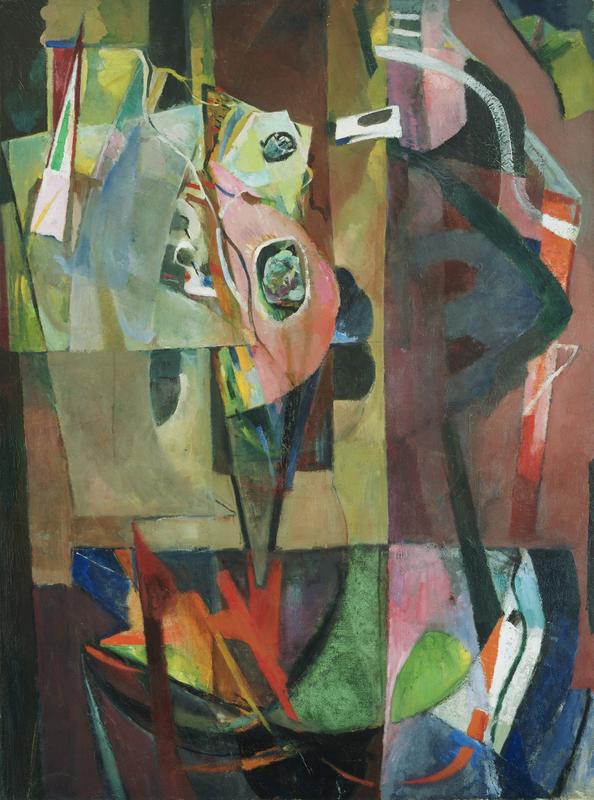More about Composition, III

Sr. Contributor
Arthur B. Carles’ Composition, III is proof that alcoholism, failed marriages, and suicide are rarely good news for anyone...except maybe therapists and divorce lawyers saving up for summer homes, and artists looking for inspiration.
This piece was painted between 1931 and ‘32, a period of Carles’ work spawned by his disastrous interlude in Paris from 1929-30.
After a promising early career that included studying under Henri Matisse, Carles was in freefall by the mid ‘20s. His first marriage to the gorgeous model, dancer, and musician Mercedes de Cordova collapsed as she took their daughter to New York, leaving him behind in Philadelphia. Meanwhile his drinking escalated to the point that he was fired from his teaching job at the Pennsylvania Academy of the Fine Arts due to alcoholism. Then his beloved mother died.
By 1929, things seemed to be looking up. Carles had remarried to Caroline Robinson, a pretty new muse 16 years younger than him, and had another daughter. Furthermore, wealthy friends and patrons sent him and his new family to Paris to rejuvenate his career. However, his drinking and erratic behavior continued to spiral out of control. On a whim, he abandoned his wife and daughter on an ocean liner to make the return voyage to America without him while he jumped ship to continue drinking and carousing with his Parisian friends. He was soon devastated when fellow-artist Jules Pascin committed suicide on the eve of Pascin’s own first solo show by slitting his wrists, scrawling a note in blood on the wall to his mistress, and hanging himself. Carles returned to America in despair and failure, reportedly having only a single painting to show for the entire misadventure.
Yet, he brought something much more precious home from Paris: artistic inspiration. Influenced by groundbreaking new styles he had seen developing in France among the tragic Pascin and others, Carles embarked on a new phase of his career, eschewing the representational figure paintings and portraits of his earlier career for these much more radical compositions.
Still other forces coincided to make the early ‘30s a particularly flourishing period for Carles. He found on his return to Philadelphia that his old mentor Matisse was living nearby. Carles’ elder daughter Mercedes Matter, now a ravishing beauty of 19 and burgeoning artist in her own right, introduced him to her mentor (and much older lover) Hans Hoffman, with whom he became fast friends and collaborators. Additionally, one of Carles’ wealthy benefactors funded the construction of a specially designed studio that could only be accessed by a trapdoor in a ceiling so that he would not be disturbed.
These serendipitous boosts helped make pieces like Composition, III among Carles’ most revolutionary and highly regarded work. Biographer Barbara Ann Boese Wolanin points to “...prophecies of Abstract expressionism” in these later works, nearly two decades before artists like Jackson Pollock made the movement famous. Unfortunately, this golden age was not to last for Carles, who fell off the trapdoor staircase of his famed “ideal” studio during a drunken binge, and was paralyzed and unable to work for the rest of his life.
Sources
- Gardiner, Henry G. “Arthur B. Carles: A Critical and Biographical Stud.” Bulletin: Philadelphia Museum of Art vol. 64, nos. 302-303 (January-March 1970/April-June 1970): 177. https://www.jstor.org/stable/3795262?read-now=1&seq=41#metadata_info_ta…
- MoMA. “Arthur B. Carles: Composition, III.” Accessed June 19, 2020. https://www.moma.org/collection/works/79607
- Samet, Jennifer. “Mercedes Matter’s Awful, Wonderful Itch.” Hyperallergic, May 13, 2017. https://hyperallergic.com/378723/mercedes-matter-a-survey-paintings-and…
- Seid, Shayna. “A Look Back at Gloria Vanderbilt’s Four Weddings.” Over The Moon, June 18, 2020. https://overthemoon.com/weddings/gloria-vanderbilt-weddings-look-back/
- Sotheby’s. “Arthur Beecher Carles 1882-1952 Composition.” Accessed June 19, 2020. https://www.sothebyscn.com.cn/en/auctions/ecatalogue/lot.30.html/2014/a…
- Stern Pissarro Gallery. “Jules Pascine (1885-1930).” Accessed June 19, 2020. https://www.pissarro.art/artistdetails/231845/jules-pascin
- Stokowski.org. “1939 and 1940 Recordings of Leopold Stokowski and the Philadelphia Orchestra.” Accessed June 19, 2020. https://www.stokowski.org/1939_1940_Electrical_Recordings_Stokowski.htm
- Wolanin, Barbara Ann Boese. “The Paintings of Arthur B. Carles.” American Art Review, vol. 22, no. 2 (2000): 164-173.











